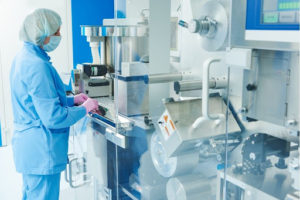The pharmaceutical business is a critical component of global healthcare systems. It consists of both governmental and commercial firms that discover, develop, produce, and sell medications. The pharmaceutical business primarily focuses on scientific research and creating medicines to prevent or cure illnesses and problems. Modern scientific and technical advancements hasten the development and distribution of novel medicines with better therapeutic efficacy and fewer adverse effects. Molecular biologists, medicinal chemists, and pharmacists all strive to enhance the effectiveness and specificity of medicines.
Drug manufacturing is the method through which pharmaceutical firms create pharmaceutical medicines on a large scale. The process of producing drugs may be broken down into a number of unit activities. The procedure may include milling, granulation, coating, and tablet pressing.
Pharmaceutical Manufacturing Steps
In continuous production, raw materials and energy are fed into the system constantly while output products are extracted continuously. The process performance is highly reliant on the material flow rate’s steadiness. Because feeding is often the initial step in production, it is critical for powder-based continuous processes to feed powders consistently and correctly into the subsequent operations in the line. Feeders are built to be dependable in terms of performance, feed rate accuracy, and downtime.
The finished blend for the solid dosage form was created using the following steps; various non-active substances may be mixed with the active pharmaceutical component or compounds in pharmaceutical production. The variety of materials may create a plethora of factors that must be handled. The particle size distribution, particle shape, the presence of moisture, particle surface characteristics such as roughness and cohesiveness, and powder flow properties are among these factors.
Many pharmaceuticals benefit from milling throughout their manufacture since it reduces the average particle size of the powder. The causes include greater homogeneity, dosage uniformity, and a better ability to dissolve pharmaceutical component molecules. It is common to adopt repeated powder mixing and milling to improve the ease of fabrication of mixes.
Granulation is classified into two types: wet granulation and dry granulation. Granulation may be thought of as the inverse of milling. Small particles join together to create bigger particles known as granules. Granulation is used for a variety of purposes. It avoids “demixing” components in the mixture by forming a granule that includes all of the constituents in the correct amounts, enhancing powder flow characteristics and compaction qualities for tablet production.
In pharmaceutical solid oral dosage manufacturing, hot-melt extrusion is utilized to deliver low solubility and bioavailability medicines. Hot-melt extrusion has been demonstrated to distribute poorly soluble medicines in a polymer carrier molecularly. The process involves using heat, pressure, and agitation to combine materials and ‘extrude’ them through a tool die. Twin-screw high-shear extruders mix ingredients while also breaking up particles. The resulting particles may be mixed, crushed, and packed into tablets or capsules.
Dry ice is used in laboratories to chill medicines for response selectivity. However, this cooling method gets complex when employed on an industrial scale. The expense of cooling a conventional reactor to this temperature is expensive, and as the temperature drops, the viscosity of the reagent increases, making mixing harder. This increases the cost of stirring harder and changing components more often, resulting in a non-homogeneous reaction.
 Pharmaceutical Manufacturing Instruments
Pharmaceutical Manufacturing Instruments
The pharmaceutical business has stringent standards and production rules. As a consequence, pharmaceutical production equipment must adhere to reasonable manufacturing procedures. Examples of pharmaceutical production equipment are capsule filling machines, x-ray inspection systems, tablet punches, and spray drying accessories. To ensure that manufacturing and formulation are done correctly, almost every step may be automated. As a consequence of automation, a piece of pharmaceutical production equipment is engaged in each stage.
Compounding operations combine solid and liquid components to create solutions, syrups, suspensions, pastes, and ointments. In the compounding of extremely hazardous chemicals, contained process equipment and transfer systems should be utilized. Worker safety may be jeopardized by buffering agents, detergents, and antiseptics. Eyewashes and safety showers assist in reducing injuries when employees come into contact with caustic or irritating chemicals. Workers in compounding areas must be safeguarded from electrical dangers of equipment and utilities because of the damp surfaces. The placement of insulation on hot surfaces and the maintenance of dry, non-slip flooring help avoid burns and falls. Safety equipment is equally important in the medication production process.
Considerations for Pharmaceutical Manufacturing
Workers’ health and safety are jeopardized during synthesis processes. They include moving machine components, pressurized equipment and pipelines, and heavy physical material and equipment handling. Steam, hot liquids, heated surfaces, and hot working settings pose additional hazards. Confined areas, unsafe energy sources, and excessive noise may all be harmful.
Workers’ exposure to toxic substances during synthesis processes may pose long-term health concerns. Chemicals having serious health consequences may cause eye and skin damage, be caustic or irritating to bodily tissues, or induce asphyxia or oxygen deprivation. Implementing a proper control measure, such as process adjustments, engineering controls, administrative processes, and personal and respiratory protection equipment, can help to minimize health and safety concerns when substances having long-term health repercussions are mishandled.
Organic synthesis reactions may provide substantial process safety hazards due to highly toxic chemicals, fire, explosion, or uncontrolled chemical reactions that affect the public in the facility’s vicinity. Organic synthesis may be a highly complicated process in terms of process safety. Investigating the kinetics of chemical reactions and the characteristics of extremely hazardous compounds aids in protection. It is also beneficial to educate operational and engineering personnel about disaster preparation and response to the facility and the surrounding community. Companies that specialize in process hazard analysis can help minimize the hazards associated with chemical synthesis processes. When producing medicines, it is essential to take every care to guarantee the health and safety of the employees.
In conclusion
This article provides an overview of pharmaceutical production. Please contact us now for additional information on related services and to check our guides.
< Previous | Home | Next >

